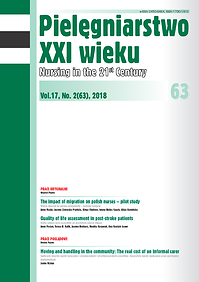Patient’s health problems after injury-related damage of cervical spine
DOI:
https://doi.org/10.2478/pielxxiw-2018-0018Keywords:
spinal injury, patient health problems, nursingAbstract
PATIENT’S HEALTH PROBLEMS AFTER INJURY-RELATED DAMAGE OF CERVICAL SPINE
In the following review there is described the case of 36-year-old patient with trauma-related fracture of cervical spine followed by tetraparesis resulting from compression and ischaemia foci of cervical spinal cord. On the basis of medical record’s analysis as well as on observation made by authors, the model of nursing process adjusted to patient’s needs is described in this article. In the course of hospitalization the typical complications were observed: respiratory tract infections, bedsores, water-electrolyte imbalances, arrhythmias, emotional disturbances resulting not only from injury but also, with high probability, as aftermath of post-traumatic stress.
Material and methods. This paper discusses the case of a patient who was hospitalized at the University Orthopedic and Rehabilitation Hospital due to cervical spine and spinal cord injury.
Method. A case study. Medical documentation was analyzed, including Intensive Care Unit (ICU) information cards and doctor and nurse reports.
The purpose of this work was to assess the impact of cervical spine injury on nursing problems with a patient admitted to ICU under life-threatening conditions.
Summary. This paper discusses the case of a 36-year-old patient with a broken cervical spine and a tetraplegia resulting from pressure and foci of ischemia in the cervical spine region. This article presents a nursing model, accounting for the problems specific to this patient, that is based on the analysis of medical documentation and observation. During hospitalization typical complications were observed – infections of the respiratory system, bedsores, electrolyte disruption, disruption of the electrical activity of the heart, emotional disturbance resulting from the injury, but also likely being post-traumatic stress disorder (PTSD) in nature.
References
1. Krause JS, Carter R, Pickelsimer EE, et al. A prospective study of health and risk of mortality after spinal cord injury. Arch. Phys. Med. Rehabilit. 2008, 89(8): 1482-1491.
2. Schilero GJ, Spungen AM, Bauman WA, et al. Pulmonary function and spinal cord injury. Respiratory, Physiology&Neurology. 2009: 166, 129-141.
3. Jaracz K, Kozubski W. Pielęgniarstwo neurologiczne. Podręcznik studiów medycznych. Warszawa: Wyd. Lekarskie PZWL; 2008, s. 421.
4. Noszczyk W. (red.). Chirurgia. Warszawa: Wyd. Lekarskie PZWL; 2005, s. 288-189.
5. Bilikiewicz A. (red.): Psychiatria kliniczna. Wrocław: Wydawnictwo Medyczne Urban & Partner; 2002.
6. Wołowicka L, Dyk D. Anestezjologia i intensywna opieka. Klinika i pielęgniarstwo. Podręcznik dla studiów medycznych. Warszawa: Wydawnictwo Lekarskie PZWL; 2014.
7. Dahm KT, Dalsbo TK, Kirkrhei I, Reinar LM. Effect of respiratory muscle training for acute traumatic high spinal cord injury: a systematic review. Report from the Norwegian Institute of Public Health; 2017.
8. Harkema SJ, Wang S, Angeli CA, et al. Normalization of blood pressure with spinal cord epidural stimulation after severe spinal cord injury. Front. Hum. Neurosci., 2018.
9. Strużyna J. Wczesne leczenie oparzeń. Warszawa: Wydawnictwo Lekarskie PZWL; 2006, s. 309-310.
10. Krajewska-Kułak E (red.), Rolka H, Jankowiak B. Standardy i procedury pielęgnowania chorych w stanach zagrożenia życia. Podręcznik dla studiów medycznych. Warszawa: Wydawnictwo Lekarskie PZWL; 2009.
11. Szulc R. Usprawnianie lecznicze krytycznie chorych. Wrocław: Wydawnictwo Medyczne Urban & Partner; 2001.
12. Kózka M. Stany zagrożenia życia. Wybrane standardy i procedury postępowania pielęgniarskiego. Kraków: Wydawnictwo UJ; 2001.
13. Krajewska-Kułak E (red.), Rolka H, Jankowiak B. Standardy anestezjologicznej opieki pielęgniarskiej. Warszawa: PZWL; 2014.
14. Zarzycka D, Ślusarczyk B. Podręcznik diagnoz pielęgniarskich. Przewodnik planowania opieki opartej na dowodach naukowych. Warszawa: GCR Media House Sp. z o.o.; 2011.
Downloads
Published
Issue
Section
License
Copyright (c) 2018 Authors

This work is licensed under a Creative Commons Attribution-NonCommercial-NoDerivatives 3.0 Unported License.




